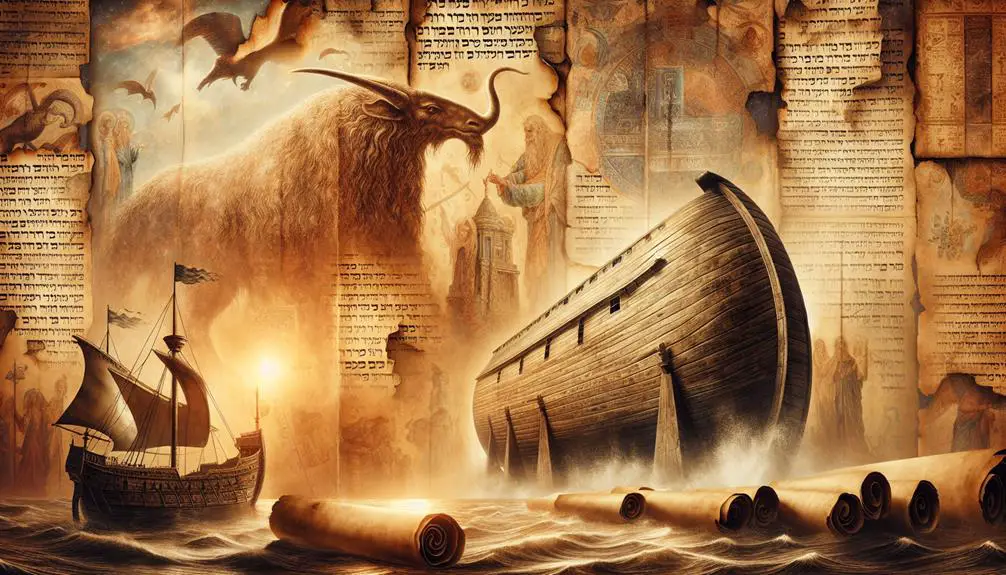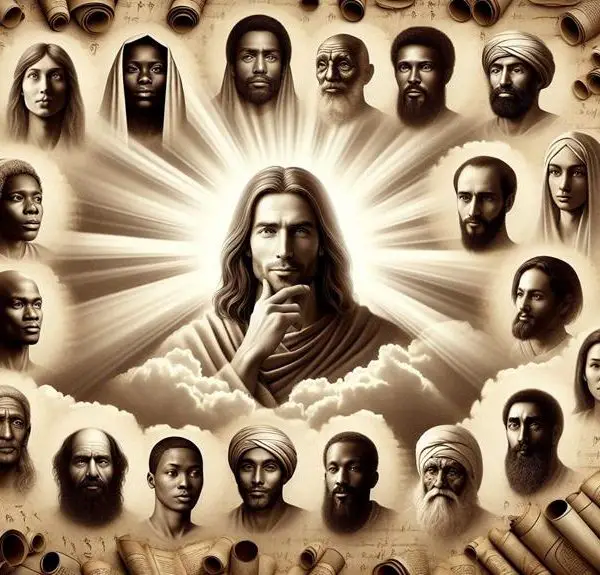Journey into the mystery of the Re Em in biblical texts, where myth and reality converge to challenge our understanding of ancient symbols.

Re Em in the Bible
The concept of Re Em in biblical texts presents an intriguing gateway into the confluence of mythology, religion, and ancient culture. Often translated as 'wild ox' in modern versions, the Re Em's appearance in scripture has sparked considerable debate among scholars regarding its actual identity and symbolic implications. This ambiguity opens a broader discussion on the intersection between literal historical truths and metaphorical narratives within religious texts.
As we explore the origins, symbolism, and cultural impact of Re Em, we invite a nuanced conversation on how ancient descriptions influence contemporary understanding, potentially reshaping our perception of biblical mythology and its relevance to modern society.
Key Takeaways
- The Re Em symbolizes divine power and strength, representing the inexhaustible power of the divine within biblical texts.
- Its depiction in ancient texts underscores its role as a formidable creature that symbolizes untamable aspects of the natural and divine world.
- The Re Em's integration into the biblical narrative highlights its profound symbolic role, enriching the theological and symbolic meanings of the scriptures.
- Historical and cultural interpretations of the Re Em extend its significance beyond the biblical context, influencing art, literature, and religious discourse.
Exploring the Origins of Re Em

Delving into the etymological roots of 'Re Em' reveals a complex tapestry of linguistic and cultural references that have shaped its depiction in biblical texts. The term 'Re Em', deeply entrenched in mythical zoology, has been a subject of fascination and scholarly debate for centuries. It is derived from ancient languages, pointing to a creature of immense power and significance. The exploration of Re'em etymology uncovers a journey through various cultures and epochs, illustrating the evolution of a concept that transcends mere mythical creature descriptions.
The pursuit of understanding the origins of 'Re Em' necessitates a foray into the realm of mythical zoology, a field that combines the study of mythological creatures with zoological insights. This interdisciplinary approach enables a comprehensive analysis of how ancient societies conceptualized and depicted 'Re Em'. Linguistic investigations reveal that the term is not isolated but rather interconnected with a broader spectrum of mythological narratives and creatures. These connections underscore the Re'em's significance in the cultural and religious imagination, illustrating its role as more than a mythical beast but a symbol imbued with multifaceted meanings.
Scholarly discourse on Re'em etymology highlights the creature's symbolic representation of strength, untamability, and divine power, which are recurrent themes in ancient mythologies. The etymological exploration, therefore, not only enriches our understanding of the 'Re Em' within biblical contexts but also offers insights into the cultural psyche and the human inclination to mythologize the natural world. This analytical journey through the origins of 'Re Em' underscores the intricate relationship between language, culture, and mythology, revealing the depth of meaning behind the biblical depiction of this enigmatic creature.
Re Em in Biblical Scripture

In examining the Re Em within biblical scripture, it becomes imperative to analyze its role and significance as portrayed in ancient texts, shedding light on its historical context and the multifaceted interpretations that have emerged over time.
This exploration will encompass a detailed examination of the Re Em's depiction, its theological implications, and its integration within the broader biblical narrative.
Through a scholarly approach, this analysis aims to provide a comprehensive understanding of the Re Em's place in biblical tradition, contributing to the ongoing discourse on its historical and religious significance.
Re Em's Biblical Role
Throughout Biblical scripture, the term 'Re Em' is referenced as a formidable creature, symbolizing strength and power within various contexts. The Re'em depictions and their mythical characteristics are deeply embedded in the ancient texts, suggesting a creature of immense might and spiritual significance. Scholars have debated the precise nature of the Re'em, but its symbolic role is undeniably profound, representing divine power and the untamable aspects of the natural world.
Aspect |
Description |
Implication |
|---|---|---|
Re'em Origins |
Biblical and mythological sources |
Divine power |
Physical Might |
Described as incredibly strong and large |
Untamable nature |
Symbolism |
Represents strength, power, and divine intervention |
Spiritual significance |
Interpretation |
Varied among scholars; linked to wild oxen or mythic beasts |
Complexity in understanding |
This table underscores the multifaceted role of the Re'em in Biblical lore, highlighting its significance beyond a mere creature, as a symbol of unparalleled strength, divine mystery, and the complexities of interpretation.
Historical Context Explained
Having explored the Re'em's symbolic significance within Biblical scriptures, it becomes essential to examine the historical context that surrounds these references to better understand their origin and evolution in religious texts.
The term 'Re'em' itself is deeply rooted in ancient linguistics, shedding light on the cultural and religious milieu from which the Biblical texts emerged. Ancient translations of the Bible have grappled with the exact nature of the Re'em, reflecting a range of interpretations that mirror the shifting understandings of the natural world among ancient peoples.
A closer analysis of these translations reveals a fascinating intersection between language, theology, and the environmental knowledge of the time, offering insights into how ancient societies conceptualized the divine and the natural world. This historical lens is crucial for comprehending the multifaceted role of the Re'em in Biblical narratives.
Interpretations of Re Em
As scholars delve into the varied interpretations of the Re'em mentioned in Biblical scripture, it becomes evident that this creature embodies a complex tapestry of theological and symbolic meanings. The Re'em's place within mythical taxonomy and its ancient depictions contribute significantly to our understanding of its role and symbolism in Biblical texts.
- Mythical Taxonomy: Scholars categorize the Re'em within a broader context of mythical creatures, analyzing its characteristics to understand its symbolic functions.
- Ancient Depictions: The way the Re'em is portrayed in ancient art and texts provides insight into its perceived power and significance.
- Theological Symbolism: The Re'em often symbolizes strength and indomitability, reflecting divine qualities.
- Cultural Context: Interpretations of the Re'em vary across cultures, influenced by historical and theological perspectives.
The Symbolism of Re Em

The symbolism of Re Em in biblical texts extends beyond its literal representation, embodying profound allegorical meanings. Its depiction often correlates with notions of unparalleled strength and divine power, serving as a metaphor for God's omnipotence and the moral fortitude of the faithful.
Furthermore, the interpretations of Re Em's symbolism exhibit considerable variation across different cultures, reflecting a rich tapestry of theological and philosophical understandings.
Re Em's Biblical Role
In biblical literature, the term 'Re Em' symbolizes immense power and untameable strength, reflecting a deeper theological and moral significance within the scriptural narrative. This creature's depiction, though not extensively detailed, provides subtle insights into its existence and importance:
- Re'em Diet: The scant references suggest a creature sustaining itself in harsh environments, indicative of divine provision and the balance of creation.
- Habitat Specifics: Its dwelling in remote, untamed landscapes symbolizes God's dominion over all creation, including the wildest realms.
- Theological Significance: Represents God's unbridled power and the awe-inspiring aspects of His creation.
- Moral Implications: Encourages reflection on human limitations and the necessity of humility before the divine.
Analyzing the Re'em's biblical role uncovers layers of symbolism, enhancing our understanding of scriptural themes.
Strength and Power Symbolism
Exploring the symbolism of Re'em within biblical texts reveals a profound representation of strength and power, reflecting fundamental theological concepts. The depiction of this formidable creature, often through muscular metaphors, serves not merely as a portrayal of physical might but as a manifestation of divine strength.
This symbolic association underscores the omnipotence of the divine, positioning the Re'em as an emblematic creature that transcends mere animalistic attributes. The use of such potent imagery within the scriptures highlights the intertwined nature of physical vigor and spiritual authority, suggesting that divine strength underpins the very fabric of creation.
Thus, the Re'em emerges not just as a symbol of brute force but as a metaphorical conduit for expressing the inexhaustible power of the divine.
Interpretations Across Cultures
Across various cultures, the symbolism of the Re'em has been interpreted through diverse lenses, reflecting a rich tapestry of mythological and theological perspectives. This multifaceted creature embodies a range of significances, intricately woven into the fabric of cultural rituals and mythological parallels.
- In Near Eastern cultures, the Re'em symbolizes unrivaled strength, integrated into myths as a creature only heroes could confront.
- Within Jewish tradition, it represents the indomitable spirit of faith, often mentioned in conjunction with God's omnipotence.
- In Christian allegories, the Re'em is seen as a symbol of Christ, embodying sacrifice and resurrection.
- Amongst pagan traditions, parallels are drawn with similar mythological beasts, symbolizing natural forces and human mastery over the untamable.
Each interpretation enriches our understanding of the Re'em, bridging cultural divides through shared mythological narratives.
Historical Accounts and Re Em

Throughout history, the term 'Re Em' has been subject to various interpretations and discussions within biblical scholarship, reflecting its complex and multifaceted nature in religious texts. This mythical creature, mentioned in the Bible, has intrigued scholars and theologians alike, leading to a rich tapestry of historical accounts and scholarly analyses. The examination of Re Em in historical contexts bridges the realms of mythological beings and biblical zoology, offering a unique perspective on ancient narratives and their interpretation through time.
The discourse around the Re Em's taxonomy and mythical accuracy has been particularly prominent among scholars. This discussion not only highlights the challenges in deciphering ancient texts but also underscores the evolving nature of biblical interpretation. The classification of Re Em within the broader spectrum of mythical creatures in religious literature poses significant questions regarding its existence, characteristics, and symbolism.
To add a level of sophistication to this discourse, the following table presents a concise overview of key aspects concerning the historical accounts and scholarly analysis of Re Em:
Aspect |
Description |
|---|---|
Re Em Taxonomy |
Debate over whether Re Em is a mythical creature or a misinterpreted animal. |
Scriptural References |
Found in Job 39:9-12; Deuteronomy 33:17; and Psalms 29:6; 22:21, indicating its significance in biblical narratives. |
Mythical Accuracy |
Scholars analyze linguistic and archaeological evidence to gauge the creature's basis in reality. |
This analytical approach allows for a deeper understanding of the Re Em's place within biblical scholarship, bridging the gap between ancient myth and historical accuracy.
Debates and Interpretations

Given the complexity of the Re Em's depiction in biblical texts, debates and interpretations among scholars have varied widely, reflecting a spectrum of perspectives on its existence and symbolism. This diversity in understanding underscores the multifaceted role of the Re Em within scriptural narratives and its broader implications in theological and literary studies.
- Existential Debate: One of the primary areas of contention revolves around the literal versus metaphorical existence of the Re Em. Some scholars argue that references to this creature are grounded in historical encounters with now-extinct large animals, suggesting a basis in reality. Others view the Re Em as purely symbolic, an animal metaphor embodying strength, untamability, and divine mystery.
- Symbolic Interpretations: The symbolic readings of the Re Em vary significantly. For some, it represents the indomitable nature of God's creation, impossible to be mastered by humans, while for others, it symbolizes chaos or evil, beings that only divine intervention can control or vanquish. This disparity highlights the Re Em's utility as a versatile theological symbol.
- Mythological Parallels: Scholars draw comparisons between the Re Em and creatures from other ancient mythologies, suggesting a shared cultural lexicon of mythical beasts across civilizations. These parallels open discussions about the cross-cultural exchange of mythological motifs and the universal themes they represent, such as power, divinity, and the natural world.
- Textual Analysis: Detailed linguistic and textual analyses have fueled debates about the accuracy of translations and interpretations of biblical passages mentioning the Re Em. These discussions underscore the challenges of understanding ancient texts and the importance of contextual knowledge in unraveling their meanings.
Through these debates and interpretations, the study of the Re Em in biblical texts offers insights into the complexities of animal metaphors and mythological parallels, enriching our understanding of ancient narratives and their enduring significance.
Re Em and Its Cultural Impact

The cultural impact of the Re Em extends beyond biblical narratives, influencing art, literature, and religious discourse in significant ways. This mythical creature, often depicted as a powerful and untamable beast, has captured the imagination of artists and writers, leading to the creation of various Reem artifacts. These artifacts, ranging from medieval tapestries to modern sculptures, not only reflect the fascination with the Re Em but also serve as a testament to its enduring legacy in cultural expressions. They encapsulate the awe and mystery that the Re Em has inspired across ages, embodying the intersection of myth and material culture.
In literature, the Re Em has been a symbol of insurmountable strength and divine mystery, echoing its biblical portrayal. Its appearances in religious texts have imbued it with a layer of spiritual significance, making it a subject of theological exploration and interpretation. This has led to its incorporation into religious discourse, where it often represents God's unbridled power and the wonders of His creation.
The Re Em's cultural impact is also evident in its mythological parallels. Across various cultures, creatures similar to the Re Em appear, suggesting a shared mythological understanding of colossal beasts. These parallels not only highlight the universality of certain mythological themes but also illustrate how the Re Em has been a bridge in connecting disparate cultures through common imagery and symbolism. The exploration of these mythological parallels further enriches our understanding of the Re Em's place within a broader cultural and historical context, underscoring its significance beyond its biblical origins.
Comparative Mythology: Re Em

Exploring the Re Em's mythological counterparts across different cultures reveals a fascinating tapestry of interconnected legends and shared symbolic meanings. The Re Em, often rooted in ancient Hebrew texts, presents a compelling study in comparative mythology. Its etymology and mythological parallels across various cultures invite an in-depth analysis.
- Greek Mythology – The Behemoth and Leviathan: The Re Em's resemblance to the Behemoth in Jewish lore, often paralleled with the Greek myth of the Leviathan, underscores a shared motif of cosmic beasts representing chaos and creation. This parallel extends to the etymology of 'Re Em,' which some scholars suggest may denote strength or primacy, similar to the Leviathan's depiction as a formidable creature of the sea.
- Hindu Mythology – The Makara: Hindu mythology introduces the Makara, a sea creature that symbolizes the threshold between perceptible material reality and the unknown. The Re Em's symbolic representation of untamed nature finds a counterpart in the Makara's embodiment of life's mysteries, highlighting a shared thematic element across these cultures.
- Norse Mythology – Jörmungandr: The Jörmungandr or Midgard Serpent in Norse mythology, encircling the world, mirrors the Re Em's encompassing presence in biblical texts. Both creatures signify the bounds of the world and the inevitable chaos that lies beyond, illustrating a common mythological motif of boundary and order.
- Mesopotamian Mythology – The Bull of Heaven: The Mesopotamian Bull of Heaven, a creature sent to punish the hero Gilgamesh, shares similarities with the Re Em in its representation of divine wrath and natural forces. This parallel not only underscores the shared mythological themes but also the Re Em's etymological roots in depicting formidable strength.
These mythological parallels offer a window into understanding the Re Em beyond its biblical context, revealing a world where myths, regardless of origin, reflect shared human concerns and curiosities.
Modern Perspectives on Re Em

Shifting focus to contemporary interpretations, it becomes evident that the Re Em's significance extends beyond ancient mythologies, resonating with modern scholars and enthusiasts in diverse and meaningful ways. The exploration of Reem ecology in contemporary studies provides a fascinating intersection between mythological creatures and real-world environmental science, suggesting that these ancient narratives may have been grounded in early observations of nature and animal behavior. This perspective not only enriches our understanding of the myth but also highlights the ancients' keen observation and interpretation skills, which modern ecology continues to unravel and appreciate.
Further, the examination of mythological parallels between the Re Em and other legendary creatures across cultures has opened new avenues for interdisciplinary research, bridging the gap between mythology, history, and comparative religion. Scholars argue that such parallels are not mere coincidences but rather indicate a shared human experience and a common attempt to make sense of the natural world through the lens of myth. This has led to a deeper appreciation of the universality of mythological themes and their relevance in contemporary ecological and cultural discourses.
In essence, modern perspectives on the Re Em not only underscore its enduring allure but also illuminate its relevance to current discussions on mythology's role in understanding ecology and shared human heritage. The analytical exploration of Reem ecology and mythological parallels thus contributes significantly to our comprehension of ancient narratives and their lasting impact on contemporary thought, bridging millennia through the continuous quest for knowledge and meaning.
Frequently Asked Questions
How Has the Depiction of Re Em Evolved in Contemporary Art and Media?
The depiction of the Re'em in contemporary art and media has undergone significant evolution, reflecting broader shifts in cultural narratives and symbolic meanings.
Modern interpretations often diverge from traditional portrayals, infusing Re'em symbolism with nuanced perspectives that resonate with contemporary audiences.
This evolution underscores a dynamic interaction between ancient lore and modern sensibilities, highlighting how mythological elements can be reimagined to reflect current values, concerns, and artistic trends.
Are There Any Specific Dietary Habits or Ecological Roles Attributed to Re Em in Ancient Texts Outside of the Bible?
Ancient interpretations of mythological creatures often include specific details regarding their diets and ecological roles, critical for understanding their symbolic significance.
When examining accounts outside the biblical context, it becomes apparent that there is limited information on the dietary habits or ecological functions attributed to such entities, including the re'em.
However, mythological comparisons with similar creatures in other cultures might offer insights, suggesting a blend of natural and supernatural attributes shaping their perceived existence and interactions.
What Are the Psychological Interpretations or Implications of the Re Em Myth in Modern Psychoanalytic Theory?
In the realm of psychoanalytic theory, Re'em symbolism is deeply analyzed for its psychological implications, evoking the shadowy depths of the human psyche.
This mythic creature embodies psychological archetypes, representing untamed forces within the subconscious.
Scholars dissect its representation, suggesting that the Re'em mirrors aspects of our inner world that are both formidable and elusive.
Through this lens, the myth becomes a rich source for understanding the complexities and dualities inherent in human nature.
Has the Concept of Re Em Influenced the Design or Narrative of Any Major Video Games or Virtual Realities?
The exploration of ancient myths and their influence on contemporary media is a burgeoning area of study, particularly in the realm of video games and virtual realities. The integration of mythological elements can profoundly shape game mechanics and the crafting of virtual landscapes, offering players immersive experiences that draw from deep cultural wellsprings.
However, a direct correlation between the concept of re'em and specific major video games or virtual realities has not been extensively documented.
Can Re Em Be Linked to Any Specific Astronomical Phenomena or Celestial Bodies in Ancient or Modern Astrology?
The inquiry into whether the concept of Re Em can be associated with specific astronomical phenomena or celestial bodies within the realms of ancient or modern astrology necessitates a detailed examination.
This involves a thorough analysis of star alignments and Zodiac symbols to discern any potential correlations.
Such an exploration is pivotal in understanding the broader implications of celestial influences on mythological constructs, further enriching our comprehension of astrological and astronomical connections.
Conclusion
In conclusion, the enigmatic figure of Re Em in biblical texts continues to captivate scholars and theologians alike. Its elusive nature fuels ongoing debates regarding its literal versus symbolic interpretation. Historical and cultural examinations provide a richer understanding of its significance across various societies.
Comparative mythology further illuminates the Re Em's place within a broader tapestry of ancient narratives. Ultimately, the study of Re Em offers invaluable insights into the complexities of ancient religious thought, underscoring the enduring quest for knowledge and understanding in the human spirit.



Sign up